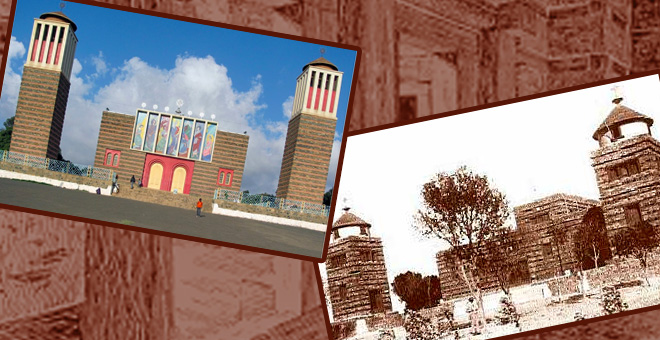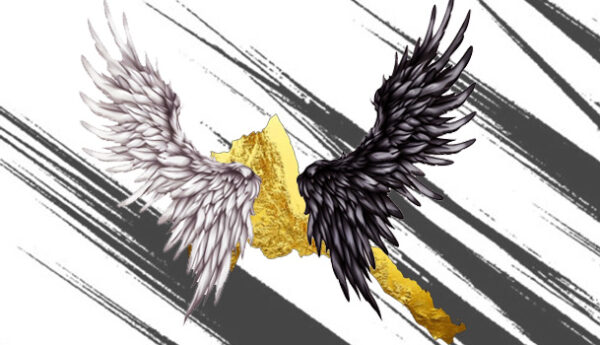Maryam Asmereyti

One of the unfortunate victims of the Tigray whirlwind, especially in its subsiding phase when Tigray intellectuals, its diaspora tentacles and their sympathizers recoiled & huddled physically or mentally in Mekelle, was the capital city of Eritrea, Asmara, and particularly its ancient church of St Mary or Enda Maryam also known as Maryam Asmereyti.
These two symbols of Eritrea became the elixirs particularly of few but influential “historians” coming repeatedly to the interviewer’s Divan to share their baseless falsified stories. They said Enda Maryam church was built by Ras Alula and his Tigrayans. Furthermore, they summarily added Asmara was found by Ras Alula, though admittedly he contributed to its expansion. The Amharic proverb that goes as “an unoccupied monk unstitches and stitches his cowl” describes well these intellectuals.
The objective of such ballyhoo was clearly expropriation and appropriation of history trying to deplete the locals of any capability of (agency to) such endeavor. Although incongruous, this idea emanated from the proverbial Civilizing-Mission invaders pontify trying to humanize their inhumane act. Strangely enough, these same intellectuals claim oneness and sameness of people with the highlander Tigrigna speakers across-Mereb river, a population they want to emasculate and deprive of any belongings.
NO, neither Enda Maryam church nor Asmara were found by the invading Ras or by Tigrayans. Enda Maryam church and Asmara preceded Alula by many centuries and the church was most likely as old as the Debre Damo Mountain top church in Tigray just south of Mereb.
As strangely as it gets, again, these same intellectuals use, a map from a book (1), trying to find a proof of the existence of their dream of elevating Tigray to a Nation. A map found in Emanuelle Barradas’s narrative of his 10 years stay in Abyssinia between 1624 and 1634. Never mind what the narrative text in the book says to the contrary, they finger point to that map, to claim the territories of their “Tigray Nation”. Ironically, it is in that Manuel Barradas’s narrative that provides a substantial history of Enda Maryam church, proving the church was as old as people can’t precisely remember, sending it to the birth of the religion itself. A simple Google translation from Barradas narrative publication “Il Tigrè” by Camillo Baccari says the following about the ancient church (2):
《 … Here I will give a hint of three other very ancient churches, which are in Tigrè and not they depend on any monastery. The first is the one found a day’s journey northeast from Debaroa, in a village called Asmara, dedicated to the Blessed Virgin, a church that I saw for the first time when I entered Ethiopia, being on my journey, and then many and many more times I visited. in that year that country was subject to my jurisdiction. It is rectangular and not very large: it has three naves, divided by twelve very large columns, six on each side. What the inhabitants tell, or rather fable about it, is that it was built by some giants who lived in Adeconò, or rather Archico (ሕርጊጎ), and although this town is distant from Asmara three- or four-days’ walk, even every night they went back to sleep at their house. The place where the church was built was an impenetrable forest, and one fine day, with universal amazement, the completed church appeared in sight of all. This would have happened fifteen years before the birth of Our Lord, so that the Virgin had just been born that already in her honor this church was built in Ethiopia! The Abyssinians of this absurd legend are so tenacious, that precisely for this reason the church is in the greatest veneration throughout Tigrè. 》
The word Tigrè (ትግሬ) designates the people on both sides of the Mereb river as Tigrigna speakers, not a separate independent nation. In the same narrative, Barradas says “as part of Abyssinia, Tigrè comprises of 24 subdivisions, 12 administered by the Baharnegash and 12 by the Tigre-Mokonen and its territory doesn’t cross the Tekkeze river.”
Few words on Asmara: A town (town in terms of a meeting place) or important village existed since as early as its church, for document purpose since the 1400s or earlier as attested by cartographers and travelers. It was the first town and a place where one reposes his blistering feet after an arduous travel from Massawa (the port of entree from the sea) climbing 2340 meters of altitude from zero within ~60kms of bird’s flight distance. It is a village in the popular legendary mind of recent generation known as arba’te(four)-Asmara, is said to have originated from harmony (asmera) of four communities who came to this flat plateau of Hamasien from different places as listed below (3).
– Asmǝ, saho speaking Asawǝrta, from Akkälä Guzay.
– Sǝrǝnsǝr Tigre speaking from Sämḥar.
– Šǝlälä from the town of Wǝqro in Tǝgray.
– Gǝrättom Beǧa-speaking group of Bäläw
This origin of the name of Asmara is what has been orally transmitted to the present generation. More than anything else, this harmony that established Asmara demonstrates the melting pot nature of the village that became a city of man of all kinds of origin.
More interestingly, there is a possibility that the Enda-Maryam church itself might be the source of the name Asmara. Indeed, the author (3) cites analysis of a Geez manuscript in a collection now in French National Library mentioning “wǝstä betä krǝstiyan zäʾǝgzǝʾǝtǝnä maryam zätǝssämmäy asmära” or ውስተ ቤተክርስትያን ዘእዝግትነማርያም ዘእትሰመይ ኣስመራ (transliteration Haile S). Lucini says Asmära läMaryam was the name of the church as the above manuscript shows and argues that the city’s name came from the name of the church (ዘእትሰመይ ኣስመራ) (3).
The enda Maryam church of Asmara is said to have been built in the 6th century around same time as Debre Damo, whose church architecture is similar along few other churches in Eritrea (Debre Libanos, now replaced by a different one) and Yiha church in Tigray, an architecture typical for this region (3, 4, 5). Lüpke with the Deutsch expedition of Enno Littmann is one of the first to describe whatever remains standing of the Enda Maryam church in detailed manner, the wall, the naves, the pillars, the windows and doors their measurements and dimensions, and able to reconstruct a sketch of the foundation as well (5). The original architecture of church of Asmara resisted centuries of hardship and changes where Lüpke visibly noticed different segments added at different periods.
Another visitor to Asmara, Felix Rosen of the German diplomatic mission in 1906 says as follows (6): 《 The most interesting monument of Asmara is the ancient church. Instead of the round shape common today, it has a square ground plan. The walls are built in a way that has not been practiced anywhere for a long time: they are made of quarry stones layered without mortar, with beams running between them. The great age of the church of Asmara is also expressed in the fact that its floor seems to have sunk by several steps around. It may have been buried for more than a thousand years, causing the surrounding area to rise. Between the graves, in front of the low facade, stands the bell cage, from which hang three well-tuned bell stones, which, when struck with a stick, sound like bells. 》Rosen included a photo of the church centered around the bell stones (Phonolithes) in his book.
The church continued to degrade until it was demolished and completely replaced by a newer of somewhat similar style in 1920 and then by the existing one in 1938 (7). Following the original’s demolition, few fragments of the material remained and are conserved in the Asmara Museum. More fortunately again, some of the artful pieces of the church were incorporated in the addenda buildings of existing church of 1938. These building became the Enda Maryam elementary school. Roger Sauter studied these remains and documented them with photography in a publication (8). Unfortunately, the large part of the wood and stone works that could have been preserved were dumped (1, 8).
Few photographs taken before its demolition remain. The first and most notable being that taken in 1893 by Mabel Bent the wife of British archeologist Theodor Bent, a courageous lady who accompanied her husband camera at hand, everywhere including Debre Bizen, inadvertently transgressing the No-Female-Zone of the monastery to the chagrin of the monks upon whom heavens really fell that day, probably for the first time. Imagine the poor monks discovering one of the two visiting whites was a Woman! The monks cried and immediately accompanied her down the mountain beyond demarcation line (9). The other photos of enda-Maryam were taken by the Italians and can be viewed on Wikipedia by searching Enda Maryam cathedral Asmara and then clicking the Gallery.
This very old and one of the unique churches can also be considered a martyr of abuse of the notorious Martini (Ferdinando) who coined upon the church a derogatory terms like Monkey-head (5). Furthermore, looking at traditional instrument of music (ጭራ ዋጣ), he threw his unhinged sarcasm saying “this curved thing is to violin as St Mary church is to the Florence Cathedral (10). He failed to appreciate that the ጭራ ዋጣ is more synchronized to our ears than his violin, and the monkey head in the eyes of the population was far more beautiful than the Florence Cathedral.
Decades afters Martini, the Italians when building housings called the Blue Village in a hill surrounding Asmara in HazHaz for their indigenous army (Ascaris), they erected a large office complex in the center inspired by the “Monkey head” architecture (7). The building still stands until today and cannot be easily distinguished from an ancient north-Abyssinian church for those knowledgeable about this type of architecture (4).
There is more than sufficient information and publication documenting the ancient nature of Asmara and its church. Some of the earliest sources include the Ethiopian itineraries circa 1400-1524 including those collected by the venetian Alessandro Zorzi and published by the British archeologist Osbert Guy Stanhope Crawford (11). Many of these itineraries mention Asmara as stopover or halt in the way between Abyssinia interior and Egypt or the Red Sea to other countries. Of note is the narrative of Castanhoso, a Portuguese who lived in Abyssinia in the first half of the 1500s, in his narratives of the Portuguese expedition to Abyssinia mentions the Portuguese warriors resting near Asmara where there is a church left in ruins by the moors, most definitely the Enda Maryam church even though he didn’t mention the name (12).
References
1 – Beccari, Camillo., 1903. Notizia e saggi di opere e documenti inediti riguardanti la storia di Etiopia durante i secoli XVI, XVII e XVIII, con otto facsimili e due carte geografiche (Vol. 1). Casa editrice italiana.
2 – Baccari Camillo, 1912. Il Tigre. Roma. An Italian translation of Barradas’s unedited treatise
3 – Lusini G., Asmara in ancient and medieval times: About the hidden story of a capital city. In Rassegna di Studi Etiopici, Vol 2, 2018, pp. 183-195.
4 – Leroy J., L’ Éthiopie: archéologie et culture. Brouwer, 1973
5 – Lupke Theodor Von. Die alte Kirche zu Asmara, in Reishsenbericht der expedtion topographie und geschichte Aksums. Druck und Verlag von Georg Reimer. 1913 Berlin.
6 – Rosen, Felix, 1907. Eine deutsche Gesandtschaft in Abessinien. Veit, Leipzig
7 – Barrera G, Triulzi A, Tzeggai G. Asmara. Architettura e pianificazione urbana nei fondi dell’IsIAO, 2008.
8 – Sauter Roger. L’arc et les panneaux sculptés de la vieille église d’Asmara. In Rassegna di Studi Etiopici , 1967-1968, Vol. 23 (1967-1968), pp. 220-31
9 – Bent James Theodore. 1893. The Sacred Cities of the Ethiopians. Longmans, Green and Co.
10 – Martini Ferdinando. 1895. Nell’ Affrica italiana: impressioni e ricordi ·
11 – Crawford, O.G.S., 1958. Ethiopian Itineraries Circa 1400-1524: Including Those Collected by Alessandro Zorzi at Venice in the Years 1519-1524. Cambridge university press for the Hakluyt Society.
12 – Whiteway Richard Stephen. 1902. The Portuguese Expedition to Abyssinia in 1541-1543 as by Castanhoso.





Awate Forum